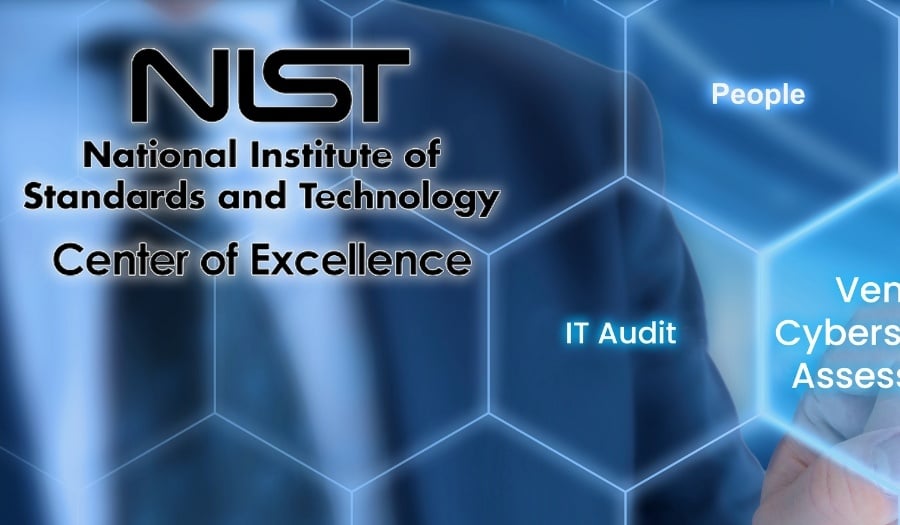NIST Vendor Security Framework 101: A Comprehensive Guide
Key takeaways from this guide:

Here are the key takeaways from this blog:
Watch our webinar on NIST CSF 2.0 for financial institutions
Organizations across every industry face rising expectations to protect sensitive data, demonstrate resilience against cyber threats, and prove compliance with government and industry regulations. At the center of these efforts stands the National Institute of Standards and Technology (NIST), a cornerstone authority on cybersecurity frameworks and risk management practices.
NIST compliance isn’t just a “checkbox” exercise. It’s the difference between safeguarding contracts, securing customer trust, and building lasting resilience or exposing your organization to costly breaches, penalties, and reputational fallout.
Failure to align with NIST frameworks leaves organizations open to today’s most dangerous attack vectors: ransomware, insider threats, supply chain compromises, and advanced persistent attacks. In regulated sectors like government, healthcare, and finance, attackers often target weak compliance programs because they know they’ll face fewer barriers.
NIST frameworks are embedded in many compliance mandates. Federal contractors, critical infrastructure operators, and entities handling sensitive data (like Controlled Unclassified Information or Protected Health Information) are expected to show alignment with standards such as SP 800-55, SP 800-171, and the recently updated NIST Cybersecurity Framework (CSF) 2.0. These frameworks don’t exist in isolation; they feed directly into broader regulations, including CMMC, FISMA, and the HIPAA Security Rule. In practice, this means NIST isn’t just a government mandate; it’s the baseline for building and proving security maturity across industries.
The consequences of falling short are significant. Non-compliance can cost organizations federal contracts, expose them to lawsuits, and erode hard-won trust with customers and partners. On the flip side, alignment demonstrates discipline and reliability, qualities that strengthen auditor confidence and set businesses apart in competitive markets.
Example: In 2024, a federal subcontractor was removed from the GSA schedule after failing to meet NIST 800-171 self-attestation. The result: millions in lost revenue and reputational damage that rippled through its supply chain.
The first step is identifying which NIST frameworks actually apply to your business. A federal agency or its contractors may need to follow SP 800-53 or SP 800-171, while a private-sector organization might lean on the more flexible CSF 2.0. The choice depends on your industry, the types of data you handle whether Controlled Unclassified Information (CUI), Federal Contract Information (FCI), or Protected Health Information (PHI) and the specific contractual or regulatory obligations you face. Getting this right is critical because every downstream activity hinges on mapping obligations to the right framework.
Once the applicable framework is clear, the next task is a gap analysis. This is essentially a mirror held up to your current security posture. Where do your existing controls align with NIST requirements? Where are the weaknesses? A thorough gap analysis goes beyond checklists; it prioritizes findings based on risk severity, compliance deadlines, and the sensitivity of data at stake. Many organizations streamline this process using NIST or compliance automation platforms that turn weeks of manual assessment into days.
Compliance isn’t achieved by technology alone. It requires clear ownership, policies, and documentation. Security leaders such as the CISO or compliance officer should establish accountability across teams, while system owners and data stewards ensure day-to-day adherence. Supporting this structure are policies covering information security, access management, acceptable use, and incident response. Just as important is how those policies are documented: every version should be audit-ready, logged, and easily traceable.
With the groundwork in place, organizations can move on to implementing controls. These span technical safeguards like access control and audit logging, as well as administrative processes such as configuration management and risk assessments. NIST guidance like SP 800-53A and 800-171A provides clarity on not only what controls to implement but also how to prove they’re effective. The goal isn’t to check off boxes but to build security measures that demonstrably reduce risk and withstand scrutiny.
Implementing controls isn’t the end of the journey. Organizations must test them. Risk assessments, vulnerability scans, penetration testing, and red team exercises help identify both inherent risks and the residual risks that remain after safeguards are in place. The key here is documentation: findings should feed into remediation plans that are tracked and measurable, ensuring compliance remains a living process, not a one-time event.
Documentation forms the backbone of NIST compliance, and two documents in particular are indispensable. The System Security Plan (SSP) details how controls are implemented across your environment, while the Plan of Action and Milestones (POA&M) lays out the roadmap for addressing gaps. These documents are required for audits under NIST 800-171 and CMMC, and they should be updated continuously, not just in preparation for an assessment.
Cybersecurity is dynamic, and so is compliance. Continuous monitoring ensures that the safeguards you’ve put in place remain effective as threats evolve. This typically involves tools like SIEM and EDR for real-time visibility, threat intelligence feeds for emerging risks, and scheduled internal audits. Metrics such as Mean Time to Detect (MTTD) and Mean Time to Respond (MTTR) provide tangible insights into how well your controls are working and where improvements are needed.
Finally, compliance requires vigilance. NIST frameworks evolve over time, and regulatory expectations shift in parallel. Organizations that keep pace by subscribing to NIST bulletins, DHS/CISA alerts, and CMMC updates are better positioned to adjust policies, technical configurations, and training programs quickly. Those who don’t risk drifting into non-compliance without realizing it.
Successful NIST programs go beyond checking boxes. They tie compliance activities directly to business goals, showing how controls reduce risk, protect revenue, and improve ROI. When executives see compliance as a driver of value rather than a cost, it becomes easier to secure long-term support and resources.
Automation is now essential to this shift. By streamlining control mapping and validating effectiveness at scale, organizations cut down on manual effort while improving accuracy. This lets compliance leaders focus on strategy instead of paperwork.
At the same time, people remain central to compliance. Training ensures employees at every level understand their role in safeguarding sensitive data, from executives shaping policy to staff following secure practices. Embedding awareness across the organization prevents compliance from being siloed within IT.
One of the toughest hurdles in NIST compliance is dealing with multiple frameworks at once. NIST, ISO, CMMC, and CIS often overlap, but each demands its own evidence. Cross-mapped compliance platforms can simplify this by reducing duplication. Manual gap assessments are another drain, often taking weeks; AI-driven tools now cut that effort to days while improving accuracy.
Unclear audit evidence requirements also create confusion, but pre-built templates aligned to SP 800-53, 800-171, and CSF can provide clarity. And because documentation tends to become outdated, organizations benefit from version-controlled workflows with reminders to keep everything current. By addressing these pain points with the right tools and processes, compliance becomes far more manageable and sustainable.
Rivial’s platform simplifies every stage of the NIST compliance journey, from initial gap analysis to ongoing compliance management. By mapping controls across frameworks like NIST SP 800-53, SP 800-171, and CSF 2.0, our platform removes duplication and streamlines oversight. Automated evidence collection, scoring, and continuous monitoring keep programs current, ensuring you’re always audit-ready.
With dashboard insights tailored for CISOs, auditors, and compliance teams, Rivial transforms compliance from a manual burden into a manageable, measurable process.
Watch our webinar on NIST CSF 2.0 for financial institutions

Key takeaways from this guide:

Key takeaways from this GRC guide: AI's Impact on GRC: The rise of AI-driven cyber threats highlights the urgent need for organizations to...

1 min read
Here are the key takeaways from this blog: FFIEC will retire the Cybersecurity Assessment Tool (CAT) by August 2025, urging financial institutions...